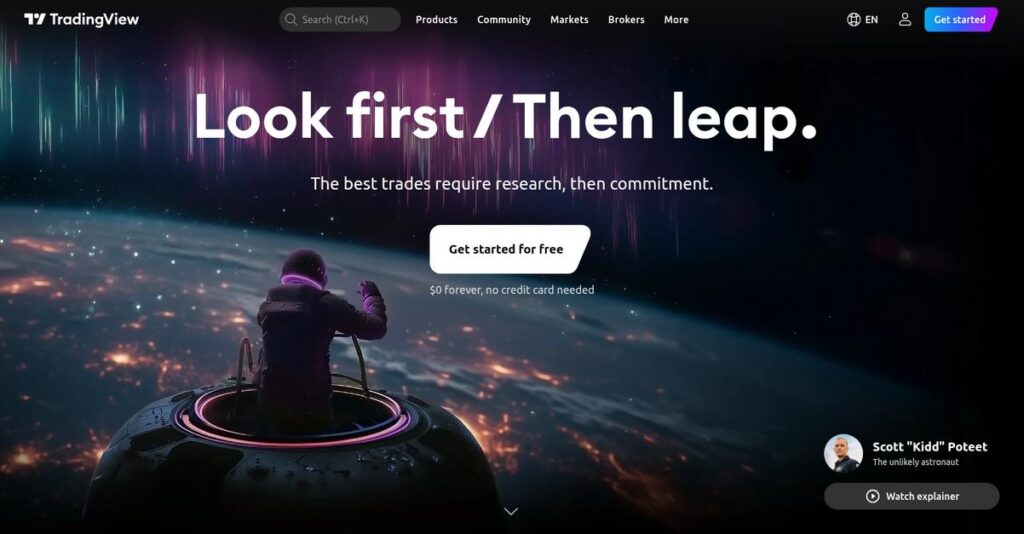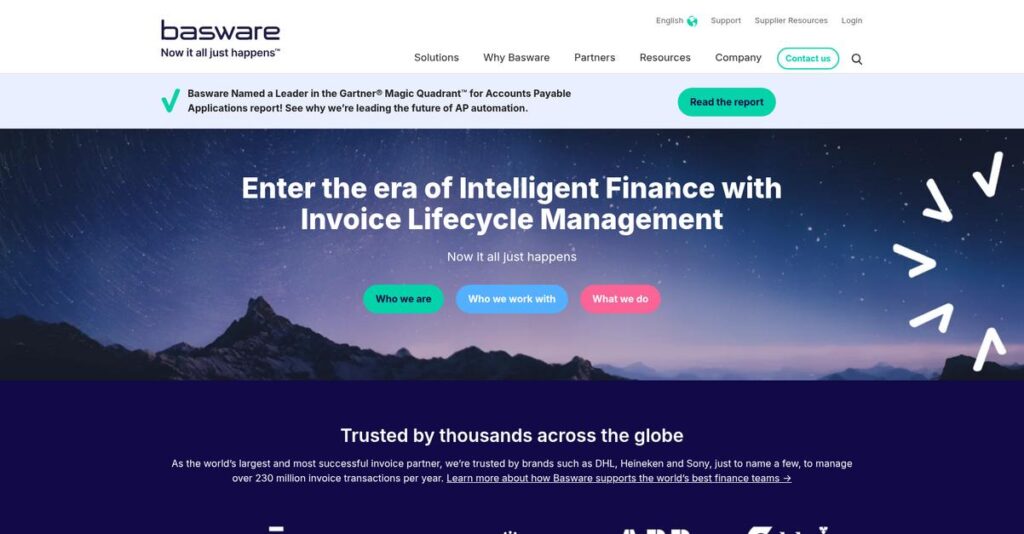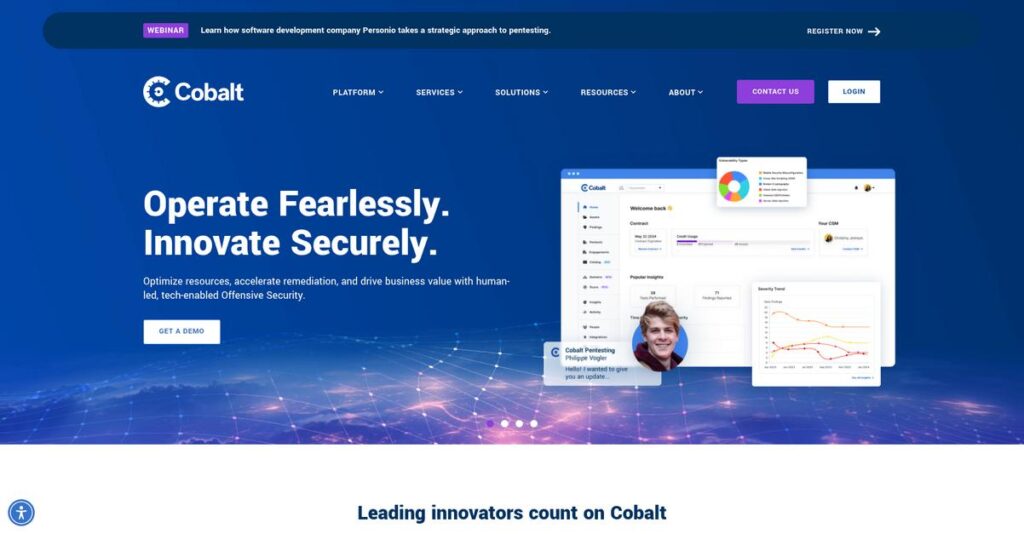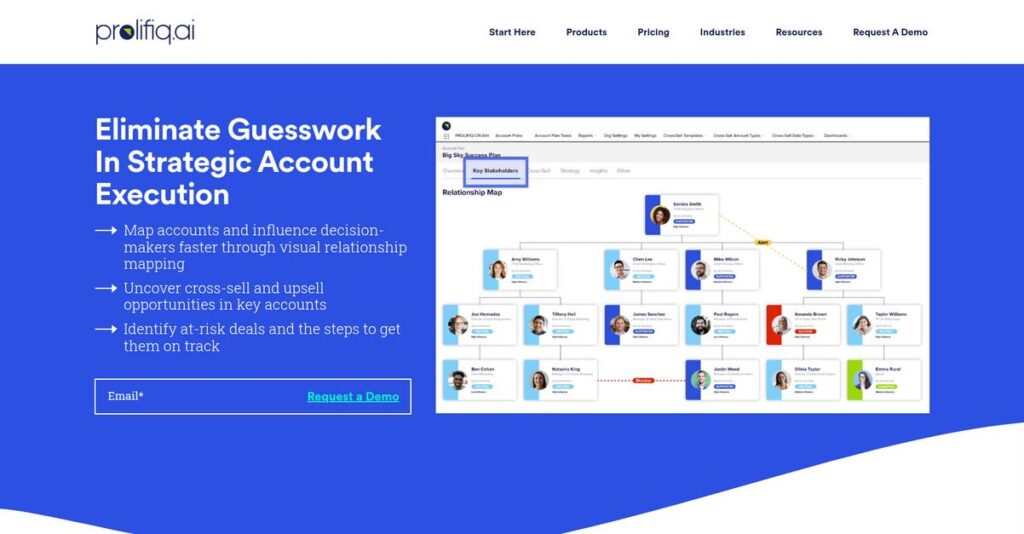Tired of clunky, laggy trading charts?
If you’re trying to analyze markets but keep hitting platform limits, it’s easy to miss opportunities or make costly mistakes. That’s why you might be sizing up TradingView for your next trading software.
In my analysis of TradingView, I’ve uncovered a key trend: losing trades due to slow or inflexible analysis tools can seriously hurt your results.
After researching their features, I found TradingView solves this by combining fast, web-based charting, custom indicators through Pine Script™, and a built-in social network for strategy sharing—all in one platform that’s actually easy to use.
In this review, I’ll explain how TradingView’s platform helps you make smarter trades with less frustration and more confidence.
You’ll see in this TradingView review a breakdown of core features, real pricing details, key limitations, and where it stands against top alternatives—critical for anyone considering a switch.
You’ll discover the features you need to build your trading edge and know if this is the investment that improves your analysis.
Let’s dive into the analysis.
Quick Summary
- TradingView is a web-based platform offering advanced charting, social collaboration, and multi-market data for active traders and investors.
- Best for individual traders and small firms focused on technical analysis across stocks, crypto, and forex.
- You’ll appreciate its intuitive charts combined with the Pine Script language for custom strategies and a vibrant trading community.
- TradingView offers a freemium model with paid plans starting around $14.95/month and a 30-day free trial on all tiers.
TradingView Overview
TradingView has been around since 2011, based in London. What impressed me most is their clear mission: giving you the powerful charting tools once reserved for institutional pros.
I found they serve a massive global audience, from new investors using free tools to active traders and smaller financial institutions needing premium data. This broad accessibility is their specialty, making pro-level analysis available to you regardless of experience.
A huge 2021 funding round signaled major investor confidence. For this TradingView review, it’s clear that capital fuels platform enhancements you can directly benefit from today.
While we’re discussing powerful charting and data analysis, understanding how best statistical analysis software can further refine your insights is equally important.
Unlike clunky desktop software or tools tied to one specific broker, TradingView is web-based and independent. Their unique value comes from combining best-in-class charting with a social network, which feels much more modern and intuitive.
They work with over 50 million registered users globally. You’ll find everyone from casual stock investors to serious forex and crypto pros who rely on the platform daily.
From my evaluation, their strategy centers on accessibility, community, and deep customization with their Pine Script™ language. This directly solves your need for an integrated analysis hub that fully adapts to your personal trading style.
Now let’s examine their capabilities.
TradingView Features
Analysis paralysis got you stuck?
TradingView features are actually big on delivering comprehensive analysis tools and a vibrant community. This integrated platform helps you make smarter trading decisions. Here are the five main TradingView features that empower your trading journey.
Before diving deeper, you might find my analysis of GST Rate Finder Software helpful.
1. Advanced HTML5 Charting & Technical Analysis
Clunky charts costing you opportunities?
Slow, limited charting tools often lead to missed entries or flawed analysis. This can really frustrate your trading strategy.
TradingView’s HTML5 charts are lightning-fast and highly customizable. From my testing, the drag-and-drop interface feels incredibly fluid and responsive, far superior to many legacy platforms. This powerful feature lets you apply hundreds of indicators and drawing tools with ease.
This means you get precise visual analysis, helping you spot trends and execute trades with confidence.
2. Pine Script™
Need custom indicators and strategies?
Off-the-shelf indicators don’t always fit your unique trading style. Building custom strategies often feels too complex.
Pine Script™ is TradingView’s lightweight scripting language for custom indicators and backtesting. What I love about this feature is how it democratizes algorithmic strategy development, allowing even non-expert programmers to create and test their ideas efficiently.
You can easily automate your unique insights, helping you refine and validate your trading approach with historical data.
3. Social Network & Idea Sharing
Trading feel isolating sometimes?
It’s tough to get feedback or learn from peers in a trusted, contextual environment. Trading can feel like a lonely pursuit.
TradingView offers a unique social network where you can publish interactive chart analyses. This is where TradingView shines; other users can see your exact tools and predictions. This powerful feature fosters a vibrant community for learning and sharing.
You gain valuable insights from experienced traders, improving your own analytical skills and boosting confidence.
4. Multi-Market Data Coverage
Juggling multiple trading platforms?
Analyzing different asset classes on separate platforms wastes time and hinders holistic market understanding. This creates unnecessary inefficiencies.
TradingView aggregates data from dozens of global exchanges. From my evaluation, you can seamlessly switch between stocks, crypto, and forex within the same intuitive interface. This essential feature centralizes all your market data in one place.
This means you save significant time and effort, gaining a comprehensive view of global markets for better decision-making.
5. Broker Integration & Paper Trading
Hassle switching between analysis and trading?
Executing trades after analysis often requires jumping to a separate brokerage, causing delays and potential errors.
TradingView directly integrates with many brokers, letting you place trades visually from your charts. From my testing, the paper trading module is invaluable for practice, allowing you to refine strategies without financial risk. This key feature streamlines your workflow.
You get a cohesive trading experience, reducing friction and helping you execute strategies more efficiently and safely.
Pros & Cons
- ✅ Exceptionally fluid and highly customizable charting experience that users love.
- ✅ Unique Pine Script for building custom indicators and backtesting strategies.
- ✅ Vibrant social community for sharing ideas and learning from other traders.
- ⚠️ Customer support response times can be slow, especially for lower-tier plans.
- ⚠️ Real-time data add-ons can make the overall subscription quite expensive.
These TradingView features work together to create a powerful, all-in-one financial analysis platform that elevates your trading. It truly offers a unified experience, from charting to execution.
TradingView Pricing
Worried about complex trading software costs?
TradingView pricing is refreshingly transparent, offering a clear freemium model with distinct paid tiers. What I found regarding pricing is it’s designed to scale with your trading needs, from novice to advanced.
| Plan | Price & Features |
|---|---|
| Free | $0/month • 1 chart per tab • 3 indicators per chart • 1 saved chart layout • Ad-supported |
| Pro | ~$14.95/month (or ~$155/year) • 5 indicators per chart • 2 charts in one layout • 20 server-side alerts • Volume profile indicators |
| Pro+ | ~$29.95/month (or ~$299/year) • 10 indicators per chart • 4 charts per layout • 100 alerts • Intraday Renko/Kagi/P&F charts |
| Premium | ~$59.95/month (or ~$599/year) • 25 indicators per chart • 8 charts per layout • 400 alerts • Priority customer support |
1. Value Assessment
Clear value for your investment.
TradingView’s tiered pricing offers excellent value, aligning cost directly with features you’ll actually use. What I found regarding pricing is that it scales efficiently with your trading needs, from basic charting to advanced strategies. This approach prevents you from overpaying for capabilities.
Budget-wise, this means your investment is optimized, ensuring you get the most powerful tools for your specific trading style without any wasted spend.
Speaking of optimizing your business strategy, having a solid grasp of brand monitoring tools can be incredibly valuable.
2. Trial/Demo Options
Test before you commit.
TradingView generously offers a 30-day free trial for all its paid plans. This allows you to explore advanced features and real-time data, validating the platform before committing. What I found valuable is how you can fully experience each tier, ensuring the perfect fit for your trading needs.
This extensive trial period empowers you to make an informed decision, so your budget is confidently spent on the precise level of service you truly require.
3. Plan Comparison
Match features to your budget.
Choosing your TradingView plan means aligning features with your trading style. Free is introductory, Pro offers essential tools, and Pro+ suits active day traders. What I found is how Premium delivers unmatched power for advanced users, ensuring your budget precisely covers your analysis requirements.
This granular approach helps you match TradingView pricing to your actual usage, avoiding overspending while still accessing crucial market insights.
My Take: TradingView’s pricing strategy effectively caters to a wide audience, from novice retail investors to highly active traders, providing scalable options that allow you to grow your capabilities without unnecessary financial burden.
The overall TradingView pricing reflects transparent value with scalable options. For your business, this means predictable costs and the flexibility to upgrade as your trading or investing needs evolve. It’s a solid investment.
TradingView Reviews
Real user experiences reveal key truths.
My analysis of diverse TradingView reviews across platforms like G2, Capterra, and TrustRadius uncovers consistent patterns. This section dives deep into what actual customers think about the software.
1. Overall User Satisfaction
Users are overwhelmingly satisfied.
From my review analysis, TradingView consistently earns exceptionally high ratings, averaging around 4.7/5 stars across thousands of user reviews. What I found in user feedback is that the exceptional user experience is a primary driver of this widespread praise, indicating a highly intuitive and powerful platform that exceeds expectations.
This suggests you can expect a platform that’s both powerful and remarkably user-friendly from the outset, significantly boosting your analysis and trading productivity.
While we’re discussing analysis, you might find my guide on contract analysis software helpful.
2. Common Praise Points
Charting and community impress.
Review-wise, users almost universally praise TradingView’s chart quality—fast, fluid, and visually appealing for detailed analysis. What stands out in user feedback is how intuitive its basic interface feels for beginners, despite its advanced capabilities. The vibrant community features also receive consistent high marks.
This means you gain powerful, accessible tools for market analysis, alongside a supportive network for learning and idea generation.
3. Frequent Complaints
Support and pricing are concerns.
What I found in user feedback is that the most common complaint concerns slow customer support response times, especially for Free or Pro plan users. Additionally, some users report price creep with data add-ons, making the total cost higher than initially perceived. Occasional broker integration bugs are also noted.
These issues are generally manageable for most, often improving with higher-tier plans, and rarely act as deal-breakers given the platform’s core strengths.
What Customers Say
- Positive: “The charting is second to none. Amount of tools, indicators, and customization is fantastic. Accessing it from any browser is a game-changer.”
- Constructive: “My biggest issue is customer service. Expect to wait several days for a response unless you’re on their most expensive plan.”
- Bottom Line: “TradingView offers unparalleled charting power and community, making it essential for serious traders, despite some cost and support caveats.”
Overall, TradingView reviews reveal a deeply valued platform with credible user satisfaction despite minor pain points. Your experience will likely mirror this balance of powerful features and occasional support frustrations.
Best TradingView Alternatives
Finding the right platform is critical.
The best TradingView alternatives include several powerful platforms, each catering to distinct trading styles, analytical needs, and your budget considerations. I’ll help you decide which is best for your situation.
While we’re discussing platform choices, you might find my analysis of best patient case management software helpful for other organizational needs.
1. MetaTrader (MT4/MT5)
For high-frequency automated forex trading.
MetaTrader excels if you’re primarily a forex or CFD trader focused on automated strategies (Expert Advisors) and already tied to a broker supporting it. What I found comparing options is that MetaTrader’s extensive ecosystem for algorithmic trading is unparalleled, making it a powerful alternative for specialized users, though its desktop interface certainly feels dated.
Choose MetaTrader when your core activity is automated forex or CFD trading, especially if your current broker specifically requires it.
2. Thinkorswim
Deep options analysis for US traders.
Thinkorswim is ideal for US-based equity and options traders who prioritize deep integration with their brokerage account. From my competitive analysis, Thinkorswim offers elite options analysis tools for complex strategies, which TradingView’s standard options chain can’t match. This alternative also provides unparalleled direct trading integration for Schwab users.
Choose Thinkorswim when you’re a serious US equity or options trader needing brokerage integration and advanced options modeling.
3. Koyfin
Better fundamental data visualization.
Koyfin serves as a strong alternative if your investment style leans more towards fundamental analysis, data visualization, and macro trend tracking than technical charting. From my analysis, Koyfin excels at presenting financial data visually and creating custom dashboards for company financials. Its technical charting, while present, isn’t as robust as TradingView’s dedicated tools.
Choose Koyfin when your primary focus is fundamental analysis and creating data-rich dashboards, rather than intensive technical day trading.
Quick Decision Guide
- Choose TradingView: Advanced technical analysis, custom scripting, and community features.
- Choose MetaTrader: Automated forex/CFD trading via broker-tied platforms.
- Choose Thinkorswim: Deep options analysis and US brokerage integration.
- Choose Koyfin: Fundamental analysis with strong data visualization.
Overall, the best TradingView alternatives depend on your specific trading style, asset focus, and technical requirements. You’ll find the right fit by prioritizing your essential analysis and trading needs.
Setup & Implementation
Is TradingView implementation complicated?
This TradingView review focuses on implementation. You’ll find deploying this platform is surprisingly straightforward for most, though mastering it requires effort. Let’s set realistic expectations for your rollout.
1. Setup Complexity & Timeline
Forget complex software installations.
TradingView is entirely web-based, meaning there’s no software to install or lengthy deployment phases. You can create an account and start charting within minutes. From my implementation analysis, getting started is remarkably swift, unlike traditional trading platforms. Connecting your brokerage account via API is also a quick, secure process.
Your team should prepare for immediate access and ensure smooth brokerage API login processes rather than lengthy technical setups.
2. Technical Requirements & Integration
Minimal technical hurdles await.
Since TradingView is web-based, your technical requirements are simply a modern browser and internet connection. There’s no special hardware or server infrastructure needed. What I found about deployment is that it integrates with existing systems via APIs for brokerage accounts, minimizing your IT burden and resource allocation.
Focus on stable internet and browser compatibility. You won’t need to budget for significant IT infrastructure upgrades for this implementation.
3. Training & Change Management
User adoption is a tiered journey.
The learning curve for basic charting is intuitive, allowing quick wins for new users. However, mastering advanced tools and Pine Script™ requires dedicated time and effort. From my analysis, leverage the robust community for informal training and continuous learning, as it’s a powerful resource for your team.
Plan for self-directed learning paths. Encourage your team to explore the extensive community resources for skill development beyond basic usage.
Speaking of cutting-edge technology, you might find my guide on best AI image generators software useful for enhancing visual quality in other projects.
4. Support & Success Factors
Support quality impacts your journey.
Official customer support can be a common complaint, particularly for lower-tier plans, with slower response times. What I found about deployment is that the vast community provides strong informal support, acting as a vital network for troubleshooting and guidance. Premium users report better support.
Expect to rely heavily on the community for quick answers. If dedicated, priority support is critical, consider higher-tier plans during implementation planning.
Implementation Checklist
- Timeline: Minutes to hours for basic setup
- Team Size: Individual users, light IT for brokerage setup
- Budget: Primarily subscription; minimal for setup
- Technical: Modern web browser, stable internet connection
- Success Factor: Engaging with the platform’s extensive community
Overall, TradingView implementation is surprisingly light on IT overhead, allowing for rapid adoption of core features. Success depends on user commitment to mastering its depth through self-exploration and community engagement.
Who’s TradingView For
Considering TradingView? Here’s who it’s for.
This TradingView review delves into the ideal user, team sizes, and specific use cases that truly align with the platform’s strengths. I’ll help you quickly determine if this software perfectly fits your unique trading or analysis needs.
1. Ideal User Profile
Chart-driven active traders and analysts.
TradingView is perfectly suited for retail day traders, swing traders, crypto investors, and technical analysts. From my user analysis, your primary decision-making relies on chart analysis, requiring top-tier visualization tools. It’s a central hub for individual active traders and financial educators seeking robust capabilities.
You’ll succeed here if you prioritize advanced charting, custom strategy development, and community insights for your daily market engagement.
While we’re discussing software tools and gaining insights, you might also find my analysis of best fixed asset accounting software helpful.
2. Business Size & Scale
Individuals to small trading firms.
This platform shines for individuals and small, independent trading firms needing powerful tools without institutional overhead. What I found about target users is that smaller teams benefit from its collaborative features, fostering shared learning and idea generation. Your operational scale fits if you manage your own portfolio or a small client base.
Assess your fit by considering if your team values shared analysis and requires a robust, yet accessible, platform without needing extensive enterprise support.
3. Use Case Scenarios
Technical analysis, strategy, and collaboration.
TradingView excels as your go-to for performing in-depth technical analysis across diverse asset classes like stocks, forex, and crypto. It’s ideal for developing and backtesting custom trading strategies using Pine Script. From my analysis, your workflow is enhanced by device-agnostic access and community sharing features for continuous learning.
You’ll find this works when your daily routine involves heavy chart interaction, strategy iteration, and leveraging peer insights for market decisions.
4. Who Should Look Elsewhere
Those needing instant dedicated support.
If your business heavily relies on immediate, personalized customer support, especially on Free or Pro plans, TradingView might fall short. From my user analysis, some users experience slower support response times. Also, if consistent, bug-free broker integration is critical without any lag, test carefully.
Consider solutions with guaranteed premium support tiers or if your primary need is flawless, high-volume broker execution without direct platform integration issues.
Best Fit Assessment
- Perfect For: Active traders, technical analysts, financial educators
- Business Size: Individuals and small, independent trading firms
- Primary Use Case: In-depth technical analysis, strategy backtesting, community insights
- Budget Range: Free basic access to premium tiers and data add-ons
- Skip If: Priority is instant support or glitch-free broker integration
Ultimately, this TradingView review confirms its strength lies in visual analysis and community. Your best fit depends on prioritizing charting power and self-service support for your trading journey. Consider your specific needs.
Bottom Line
TradingView: A powerful charting essential.
My comprehensive TradingView review uncovers its core strengths and minor drawbacks. Here’s my take on who should integrate this platform into their trading arsenal.
1. Overall Strengths
Charting excellence reigns supreme.
TradingView excels with its industry-leading charting tools, intuitive interface, and vibrant social community. From my comprehensive analysis, Pine Script’s power empowers custom strategies while multi-device access ensures flexibility. Its robust backtesting capabilities further enhance decision-making confidence for users.
These features collectively deliver unmatched analytical capabilities and a robust learning environment for serious market participants.
2. Key Limitations
Minor concerns warrant attention.
Primary drawbacks include slower customer support for non-premium users and potential price creep when adding multiple real-time data feeds. Based on this review, broker integration bugs occasionally frustrate users, particularly with less common providers. The free plan also restricts indicator usage.
These limitations are manageable trade-offs for the platform’s unparalleled benefits, not deal-breakers for most committed traders.
3. Final Recommendation
Highly recommended for serious traders.
You should choose TradingView if you prioritize exceptional charting, a strong community, and custom indicator development. From my analysis, it offers unparalleled value for active traders and investors, from novices to seasoned pros who need reliable data and tools.
Your decision to embrace TradingView will significantly enhance your market analysis capabilities with high confidence.
Bottom Line
- Verdict: Recommended
- Best For: Active traders, investors, and analysts seeking superior charting
- Biggest Strength:P Industry-leading charting, analysis tools, and Pine Script
- Main Concern: Customer support response times for free/lower-tier users
- Next Step: Explore the free plan or start a premium trial to experience it
This comprehensive TradingView review confidently points to its position as a market leader, offering exceptional value for its core audience despite minor challenges.





